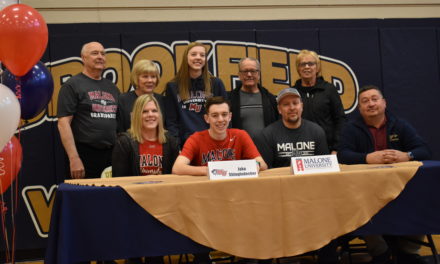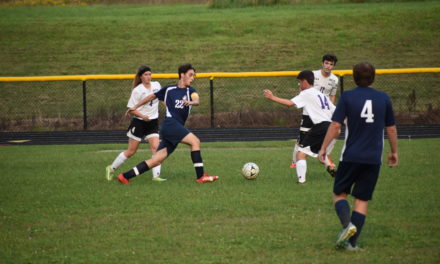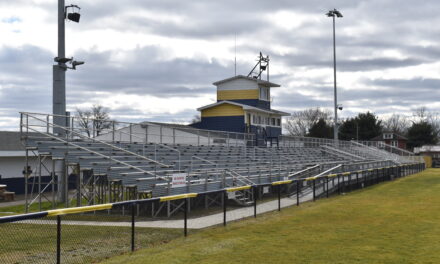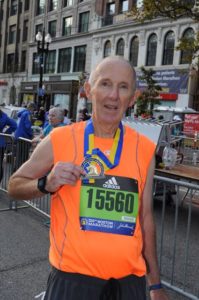
Tim Taylor displays the Boston Athletic Association medal he received for finishing the Boston Marathon.
Tim Taylor’s legs felt heavy just before the Oct. 11 Boston Marathon, a possible indication that he had over-trained for the event.
After hitting the pavement in Hopkinton, Mass., where the marathon begins, “I ran OK,” said the Brookfield schools athletic director.
But, at about the 18-mile mark, “I could tell I had nothing left,” Taylor said. Unfortunately, the 18-mile mark is about where runners encounter a series of hills.
“Those are killers,” the Brookfield man said.
If he had been running a marathon in Pittsburgh, Akron or Columbus, marathons he’s run multiple times, he might have just called it a day without finishing, he said. But, this was the Boston Marathon.
“Boston is one of those iconic marathons,” he said. No matter how spent he felt, he told himself, “I got to finish this. I might not come back.”
For the last portion of the race, Taylor alternated between jogging and walking. He finished with a “horrible” time of 5 hours and 39 minutes, an hour and a half slower than his qualifying time in the Indianapolis Marathon.
“I was glad when I got done,” Taylor said. “I’m glad to cross the finish line. It gives me the motivation to qualify again and try to go back in a year or two.”
@@@
Shawna Fedorko had a similar experience when she ran the New York City Marathon on Nov. 7.
“I was treating a knee injury before I left,” the Brookfield woman said.
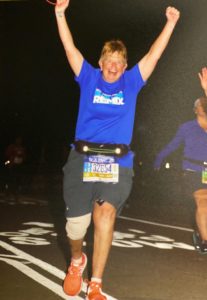
Shawna Fedorko, her injured knee wrapped, celebrates completing the New York City Marathon.
The knee didn’t bother her at first and she ran well, stopping occasionally to take photos of New York sites. Her wife, Linda, and her dad, Stan Lewis, who was back home in Hermitage following her on a tracking app, noted that her time was good.
“For the first eight miles, I was really enjoying it,” Fedorko said. “In the eighth mile, something ripped (in the knee). It took me down.”
Other runners helped her up, but she fell again. A man came over with biofreeze and rubbed her knee down.
“It helped for about a mile,” Fedorko said.
She went to a medic tent and got her knee wrapped, and hit the trail again.
“The last two miles, I was massively struggling,” Fedroko said. “I was in so much pain. I felt like my whole leg was broken up to my hip.”
Another runner saw her and asked if she was OK. The woman, whose name was Jeannette, was struggling with a back issue.
“She said, ‘I’m about ready to quit,’” Fedorko said. “I said, ‘No, you’re not quitting.’”
They agreed to help each other finish.
“We ended up holding hands and crossing the finish line together,” said Fedorko, a retired sexual and physical abuse investigator and domestic abuse counselor who now buys and sells possessions from estates.
“I finished it. My time was horrific and I don’t even wanna tell you what it was. I ran with something torn in my knee the last 18 miles.”
@@@
Although the experiences were not what Taylor and Fedorko had hoped for, competing in these particular marathons were long-time goals. Both required qualifying by time at another marathon, or, in the case of New York, being selected by lottery or sponsorship by an organization.
“It was another big challenge for me on my bucket list that I wanted to say ‘I did it,’ because not too many people can,” said Fedorko, who represented the non-profit organization Hope For the Warriors, which serves combat-wounded military service members and the families of those killed in action.
@@@
Fedorko, 54, came to running as an extension of workouts to lose weight about 25 years ago.
“I really don’t know what triggered me to really get going to running,” she said. “I think I just started running and I thought, ‘Hey, I’m not too bad at this.’ When you’re running you meditate a lot and you think a lot.”
Her motivation to run long-distance races comes from the sense of satisfaction she gets from crossing the finish line, Fedorko said.
“I’m one, I don’t have a real huge self-esteem, and I’m not one to toot my horn,” she said. “For me, internally, when I would cross that line, it was like, ‘Oh my God, I did it!’ Just more of a personal satisfaction that kind of gives me that reward mentally.”
She also likes the responses of her wife and her dad, who have supported her throughout the years. Linda is her running coach and handles the paperwork and other red tape required to enter races.
 “I saw how proud of me she (Linda) was,” Fedorko said. “After that, all I ever wanted to do was make her and my dad proud of me. It just elated me to see how proud of me they were.”
“I saw how proud of me she (Linda) was,” Fedorko said. “After that, all I ever wanted to do was make her and my dad proud of me. It just elated me to see how proud of me they were.”
For Taylor, running is a solitary pursuit. He runs three to five miles every day – six to 10 miles on Sundays – and, on days when he can’t run, he’ll work out on an elliptical to get his time in.
A basketball and baseball player when he was younger, Taylor, 72, took to running during the running boom of the ’80s.
“The nice thing about running is it can be a life-long sport, if you have some common sense about it,” he said, noting that occasional injuries are going to happen, no matter how careful you are. “You don’t have to be a tremendously coordinated or athletic individual to run.”
Runners don’t need to rely on anyone else to be able to run, nor do they need equipment, he said
“It’s something I think a lot of people find out later how many benefits there are to it,” Taylor said. “I think the message there is it’s just really healthy for you.”
Fedorko said she has not run since the New York City Marathon – she’s waiting on a doctor’s appointment to find out the severity of her knee injury – and does not plan to run marathons again. But, she does plan to do shorter races, such as half-marathons.
Taylor plans to step up his competitive running to one or two events a month – not all marathons – now that he is easing out of his job.
“I’m in my 70s and I’m still doing it,” he said, adding that he sees people in their 80s run.
“It’s one of those lifetime activities that I think are very beneficial for you,” he said.


